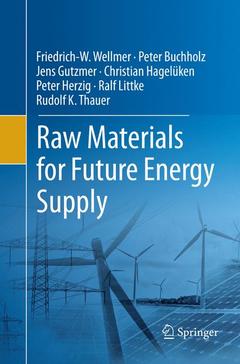Description
Raw Materials for Future Energy Supply, Softcover reprint of the original 1st ed. 2019
Authors: Wellmer Friedrich-W., Buchholz Peter, Gutzmer Jens, Hagelüken Christian, Herzig Peter, Littke Ralf, Thauer Rudolf K.
Language: English
84.39 €
In Print (Delivery period: 15 days).
Add to cartPublication date: 12-2018
Support: Print on demand
116.04 €
In Print (Delivery period: 15 days).
Add to cartPublication date: 07-2018
Support: Print on demand
Description
/li>Contents
/li>Biography
/li>Comment
/li>
Covers primary and secondary resources and substitution, not only from technical but also socioeconomic and ethical points of view
Written in a simple, straightforward style
Illustrated with more than 50 color figures and 15 tables
Includes 15 info-boxes to explain important technical terms in more detail for non-specialists




